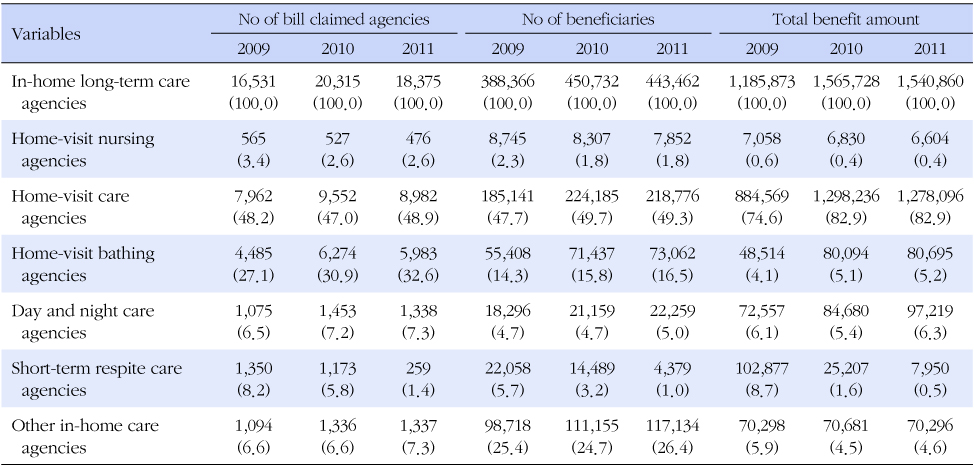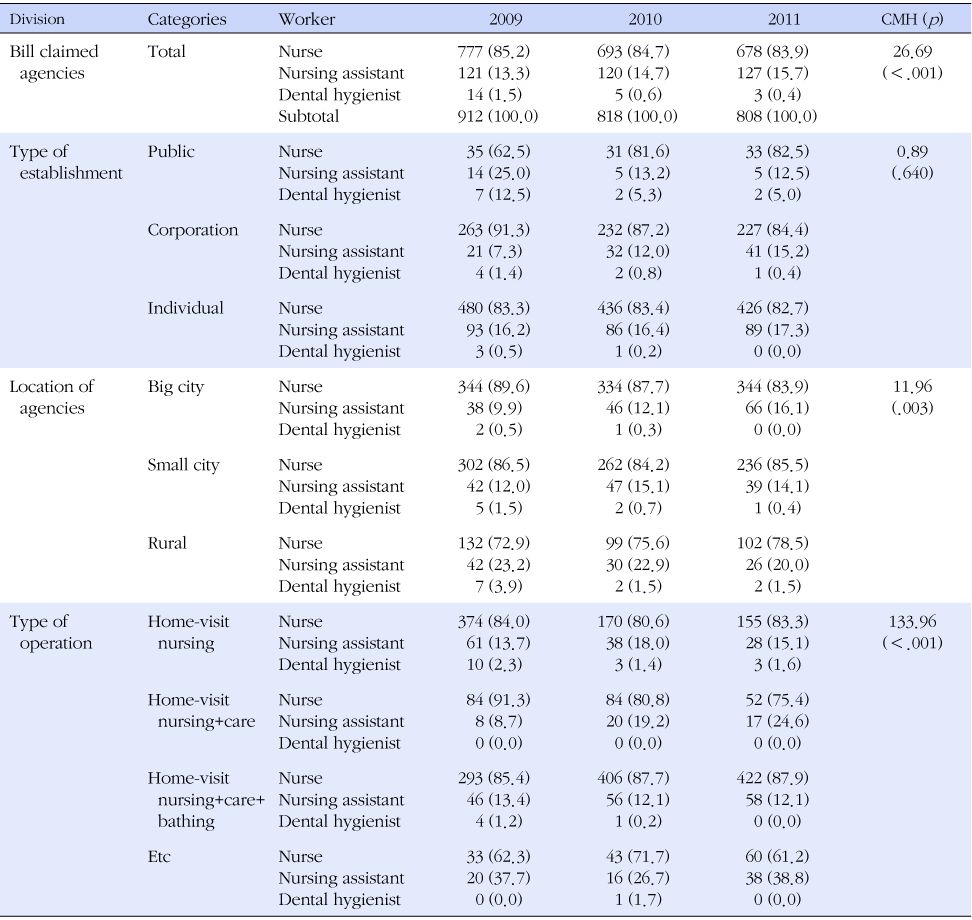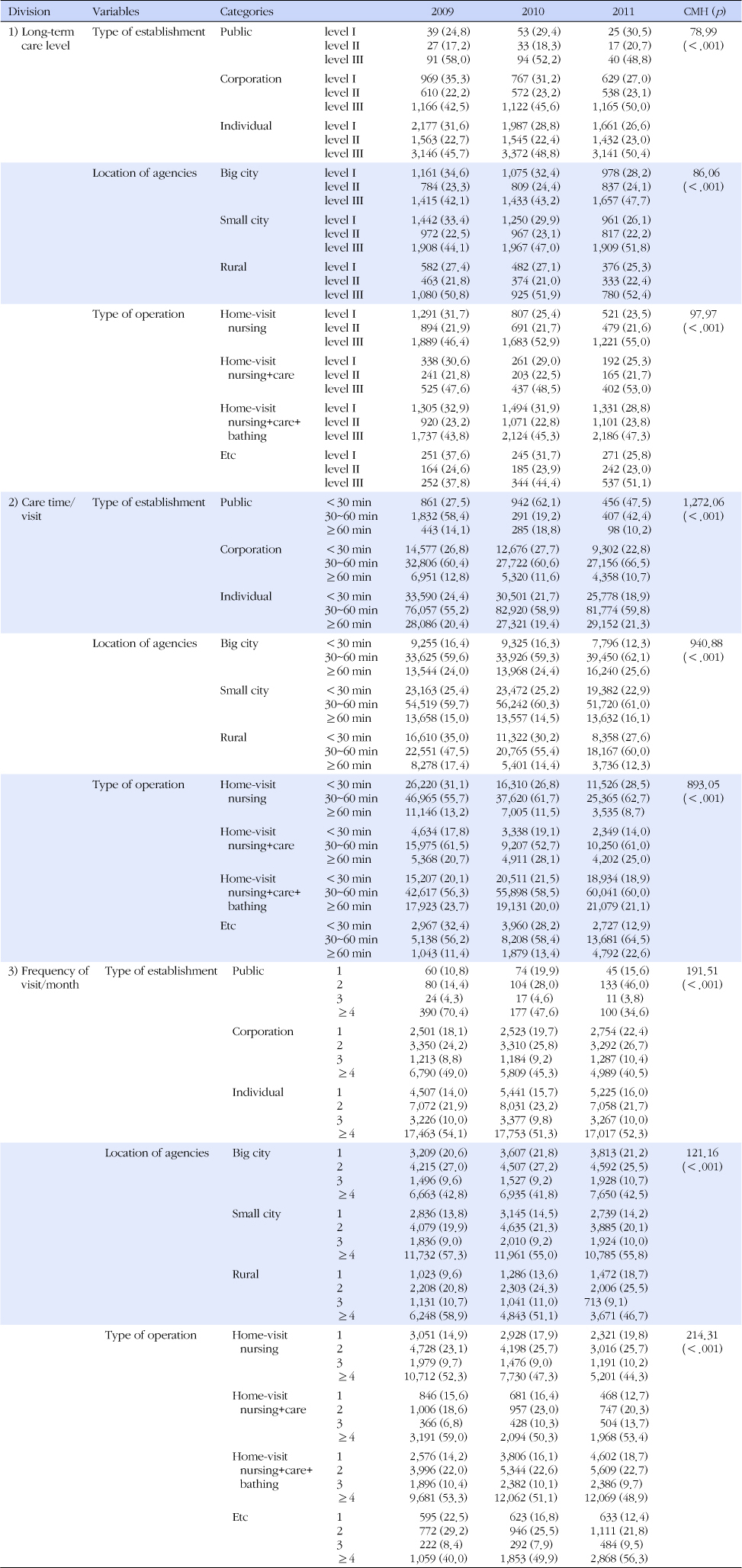Articles
- Page Path
- HOME > J Korean Acad Community Health Nurs > Volume 23(4); 2012 > Article
-
Original Article
- Trends in Home-visit Nursing Care by Agencies' Characteristics under the National Long-term Care Insurance System
- Jung Suk Lee, Rah Il Hwang, Eun Jeong Han
-
Journal of Korean Academy of Community Health Nursing 2012;23(4):415-426.
DOI: https://doi.org/10.12799/jkachn.2012.23.4.415
Published online: December 31, 2012
1Institute for National Health Insurance Policy, Seoul, Korea.
2Department of Nursing, Suwon Women's College, Suwon, Korea.
• Received: June 29, 2012 • Accepted: December 22, 2012
Copyright © 2012 Korean Academy of Community Health Nursing
- 596 Views
- 2 Download
- 5 Crossref
Abstract
-
Purpose
- This study aimed to investigate trends in home-visit nursing care by agencies' characteristics under the national long-term care insurance system.
-
Methods
- Cochran-Mantel-Haenzel tests were conducted, using data drawn from the nationwide long-term care insurance claim database of the Korean National Health Insurance Corporation from 2009 to 2011.
-
Results
- The number of home-visit nursing care agencies has decreased continuously since 2009. There were also similar trends in the total amount of service provided by home-visit nursing care agencies, the number of recipients, the number of employees, and payments. This study showed that there were statistically significant differences in the trends in home-visit nursing care by agencies' characteristics. Despite the overall downward trend, there were some increases in the percentage of home-visit nursing care provided by agencies which were established by individuals, located in large cities, and which combined home-visit care with home-visit bathing.
-
Conclusion
- Home-visit nursing care agencies are responsible for providing community-based healthcare services. For past three years, however, they have not been utilized to their full potential. Understanding the trends in home-visit nursing care by agencies' characteristics is important to develop utilization strategies for home-visit nursing care.
Table 1Change of the Number of Bill claimed Agencies, the Number of Beneficiaries, and Total Benefit Amount in In-home Long-term Care from 2009 to 2011 (Unit: Each, Person, 1,000 won)


Table 2Change of the Number of Bill claimed Agencies, the Number of Beneficiaries, and Total Benefit Amount in Home-Visit Nursing Care from 2009 to 2011 (Unit: Each, Person, 1,000 won, %)


- 1. Bang EJ, Yun SY. Health needs of the elderly in long-term care facilities: Using RAI-MDS-FC. J Korean Acad Community Health Nurs 2010;21(2):263–272.
- 2. Jung YS. A study on home visiting nursing care and medical care utilization in the elderly patients with longterm care 2012;Busan: Inje University; Unpublished doctoral dissertation.
- 3. Kim CJ, Kim YS, Kang HY, Park JH, Sun MS, Woo YJ, et al. Development of home care quality indicators( hcqis) at demonstration project of elderly care insurance program in Korea. J Korean Gerontol Soc 2008;28(2):377–394.
- 4. Kim CM, Lee JY, Ko RJ. Quality dimension of long term care hospital. J Korean Acad Community Health Nurs 2009;20(2):243–250.
- 5. Kim EK, Kim YM, Kim MA. Estimation of nursing costs based on nurse's visit time for long-term care services. J Korean Acad Nurs 2010;40(3):349–358.
- 6. Kim JH. Home-visit nursing care has been drifting along due to indifference of the insurer NHIC 2012;01 26 Retrieved December 21, 2012. The Korean Doctors' Weekly; from http://www.koreahealthlog.com/news/newsview.php?newscd=2012012500026
- 7. Kim KB, Lee HK, Sok SR. Activities of daily living and nursing needs of the elderly in nursing home. J Korean Acad Community Health Nurs 2009;20(1):1–11.
- 8. Kim MH. Roles of visiting nurses defined based on long-term care insurance regulation for the elderly. J Korean Acad Public Health Nurs 2009;23(2):232–250.
- 9. Kwon JH, Lee JS, Han EJ, Park CY. A study of policy development to prevent ill-health and improve well-being for the elderly (I) 2008;Seoul: National Health Insurance Corporation.
- 10. Kwon MY, Lim JY, Lee YH, Kim HS. A study of nurses' perception of the visiting nursing services of long-term care insurance. J Korean Acad Public Health Nurs 2010;24(1):5–18.
- 11. Lee JS, Han EJ, Kang IO. The characteristics and service utilization of home nursing care beneficiaries under the Korean long term care insurance. J Korean Acad Community Health Nurs 2011;22(1):33–44.
- 12. Lee TW. Economic evaluation of visiting nurse services for the low-income elderly with long-term care needs. J Korean Acad Nurs 2004;34(1):191–201.
- 13. Lee Y. Starting longterm in-home care agency by nurse. Korean Nurse 2008;47(1):42–45.
- 14. Lim JY, Kim EJ, Choi KW, Lee JS, Noh WJ. Analysis of barriers and activating factors of visiting nursing in long-term care insurance. J Korea Contents Assoc 2012;12(8):283–299.
- 15. Ministry of Health and Welfare. Notification No. 2011-72 of the MOHW about long-term care costs in National long-term care insurance 2011;Seoul: Author.
- 16. Moon GJ. Current status and problems of home visit nursing service within long term care insurance 2011;Seoul: Sungshin Women's University; Unpublished master's thesis.
- 17. National Evaluation Team. Interim report of progress briefing paper: Cost-effectiveness measuring effect: Emergency bed-day use 2007;Hertfordshire, UK: University of Hertfordshire Press.
- 18. National Health Insurance Corporation. The collection of long-term care insurance laws 2008;Seoul: Author.
- 19. National Health Insurance Corporation. The 2010 quality assessment reports of community-based or home-based long-term care agencies 2011a;Seoul: Author.
- 20. National Health Insurance Corporation. 2010 Long-term care insurance statistical yearbook 2011b;Seoul: Author.
- 21. OECD. The OECD health project: Long-term care for older people 2005;Paris: OECD Publications.
- 22. Park CS. Visiting nurses' services under the long-term care insurance system for the elderly. Nurs Sci 2009;21(1):64–72.
- 23. Park MS, Kang SM. Demand prospect of professional workers in execution of the elderly's long-term care insurance -nurse, Social Welfare, care probation professional workers-. Korean Commun Stat 2010;17(3):423–440.
- 24. Sung MS. A study on policies for the vitalization of the visiting nursing services with the long term care insurance. 1st anniversary of policy discussion for vitalization of the visiting nursing services with the long term care insurance 2009;Seoul.
Figure & Data
References
Citations
Citations to this article as recorded by 

- Powerlessness, Family Support and Health Promoting Behavior in Elders Using Home Service under Korean Long-term Care Insurance
Yanghee Pang, Oksoo Kim
Journal of Korean Gerontological Nursing.2017; 19(3): 184. CrossRef - Regional Comparison of Home Visiting Care Service Satisfaction among Elder Beneficiaries of the Long Term Care Insurance
Chanyeong Kwak
Journal of Korean Academy of Community Health Nursing.2016; 27(2): 114. CrossRef - Economic Effect of Home Health Care Services for Community-dwelling Vulnerable Populations
Eunhee Lee, Jinhyun Kim
Journal of Korean Academy of Nursing.2016; 46(4): 562. CrossRef - Effects of Home Care Services Use by Older Adults on Family Caregiver Distress
Jiyeon Kim, Hongsoo Kim
Journal of Korean Academy of Nursing.2016; 46(6): 836. CrossRef - Policy Implications for Home-Visit Nursing(HVN) of the Korean Long Term Care Insurance through the implications of the Japanese HVN
Hosihn Ryu, Kumi Arita
Journal of Korean Public Health Nursing.2015; 29(3): 403. CrossRef

 KACHN
KACHN


 PubReader
PubReader Cite
Cite

